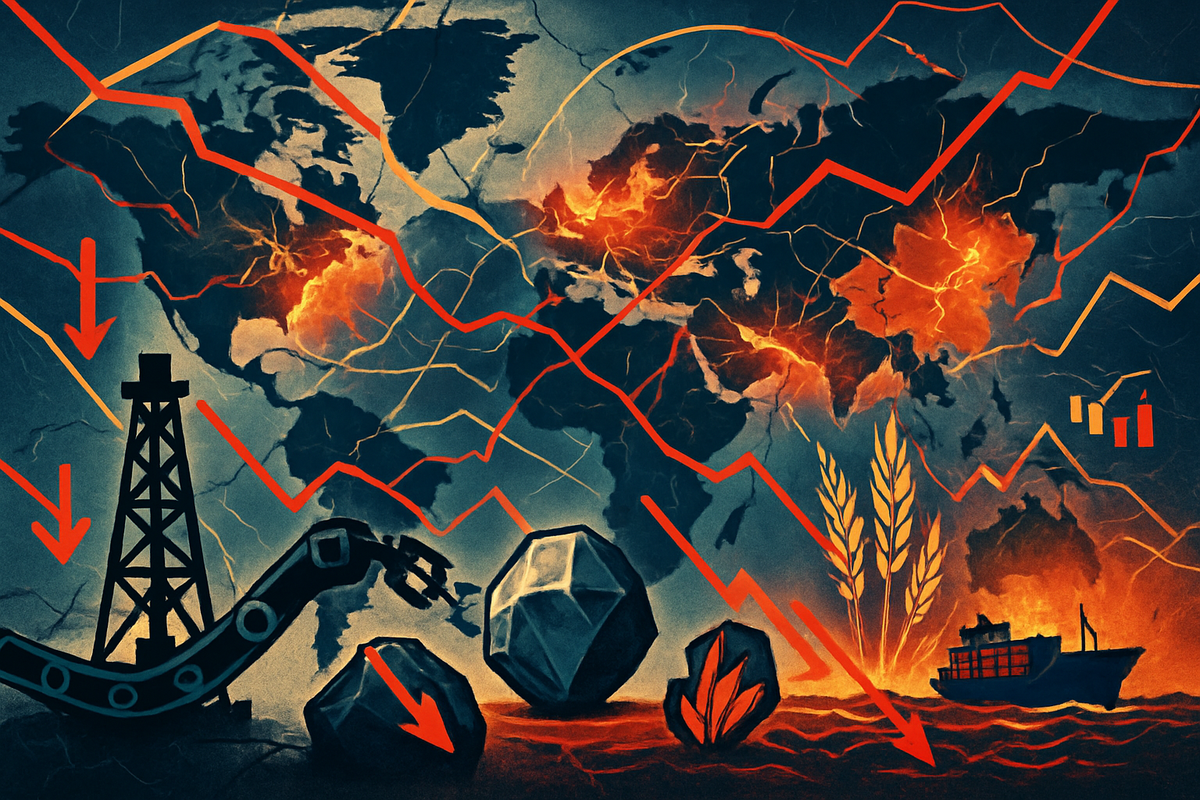
As of October 2025, the global commodity markets are navigating a tempest of geopolitical tensions, where shifting alliances, assertive resource nationalism, and persistent supply chain disruptions are redrawing the landscape of global trade and investment. This intricate web of political and economic forces is exerting significant pressure on the prices and availability of critical resources, creating an environment of heightened volatility and strategic reorientation for nations and corporations alike. While some broad economic forecasts suggest an overall easing of commodity prices in the coming year, the underlying geopolitical currents are ensuring that strategic resources remain highly contested, commanding premiums and demanding a complete rethinking of traditional supply chain models.
The immediate implications are palpable across the energy, metals, and agricultural sectors. Oil markets, despite a projected surplus, are experiencing a persistent "war premium" due to Middle East instability, while natural gas prices are on an upward trajectory. Critical minerals, essential for the global energy transition, are at the epicenter of resource nationalism, leading to price surges and an urgent scramble for diversified supplies. Meanwhile, ongoing conflicts and unexpected data blackouts continue to disrupt agricultural exports, threatening global food security and market stability. This complex interplay necessitates an agile and forward-thinking approach from all market participants, as the rules of engagement in commodity markets are fundamentally being rewritten.
A Year of Unprecedented Geopolitical Realignment and Market Shocks
The year 2025 has been defined by a series of geopolitical flashpoints and strategic realignments that have profoundly impacted commodity flows. The protracted Russia-Ukraine war continues to disrupt crucial energy and agricultural exports, with both sides intensifying attacks on vital infrastructure, particularly affecting coking coal and grain supplies. Concurrently, renewed hostilities in the Middle East, involving Israel, Iran, Yemen, and Saudi Arabia, have injected a significant "war premium" into oil prices, despite ongoing diplomatic efforts for de-escalation. The ever-intensifying US-China rivalry has transcended trade disputes, manifesting in targeted sanctions and export controls on critical technologies and materials, further complicating global supply chains, especially for rare earths and advanced components. Tensions in the South China Sea and around Taiwan remain a persistent threat, holding the potential for wider disruptions.
A defining characteristic of this period is the accelerated formation of new trading blocs and strategic alliances, often driven by geopolitical alignment rather than purely economic efficiency. Emerging markets are increasingly leveraging their control over critical resources like copper, nickel, and cobalt to assert greater influence, shaping new partnerships in both commodity and defense sectors. Organizations like the Shanghai Cooperation Organization (SCO) are gaining prominence, signaling a fracturing of the traditional global order. Nations are prioritizing strategic autonomy, exemplified by defense partnerships such as the Saudi-Pakistan nuclear umbrella and India's "Make in India" initiative, all aimed at securing vital resources and reducing dependency on potentially unreliable partners.
Resource nationalism has emerged as a dominant force, with governments in resource-rich nations asserting greater state control over their natural wealth. This trend, driven by national security, economic leverage, and domestic industrial policy, is particularly evident in the critical minerals sector. Countries like Chile, the world's largest lithium producer, and the Democratic Republic of Congo (DRC), a major cobalt source, have imposed stricter state ownership requirements and higher royalties, creating significant instability in global supply chains for battery metals. In a landmark move in October 2025, China, a pivotal player in rare earths, implemented new export controls on rare earth production technologies and specific critical elements, directly impacting global magnet and electronic component manufacturing and accelerating urgent efforts worldwide to diversify these critical supply chains.
These geopolitical shifts have cascaded into persistent supply chain disruptions. Beyond the direct impacts of conflicts, escalating trade barriers and strategic resource competition, particularly in the mining and metals sector, are redefining global logistics. Speculation around potential U.S. tariffs on copper imports, for instance, has already begun to re-route global copper flows and distort prices. Adding to the uncertainty, a U.S. government shutdown in October 2025 caused a blackout of vital agricultural data, leaving global grain and soybean traders "flying blind" during peak harvest season and introducing significant market uncertainty and price volatility. This confluence of factors underscores a global pivot from cost-efficiency to supply chain resilience, with investors and governments prioritizing projects in more stable jurisdictions.
Corporate Winners and Losers in a Fragmented Market
The current geopolitical climate is creating a distinct bifurcation in corporate fortunes, rewarding companies with diversified supply chains, domestic production capabilities, or access to critical resources in politically stable regions, while penalizing those heavily reliant on single-source suppliers or operating in high-risk zones.
Companies engaged in the extraction and processing of critical minerals outside of China are experiencing a significant uplift. For instance, USA Rare Earth (OTC: USAR) saw its shares surge dramatically in October 2025 following China's export controls on rare earth technologies, highlighting the market's appreciation for alternative, secure supply sources. Similarly, mining companies with operations in politically stable jurisdictions, particularly those producing lithium, cobalt, and copper, are poised for growth. This includes firms like Albemarle Corporation (NYSE: ALB) and Ganfeng Lithium Group Co. Ltd. (OTC: GNENF), provided their non-Chinese operations can scale to meet demand. These companies benefit from increased investment flows as nations and industries de-risk their supply chains.
Conversely, manufacturers heavily dependent on specific critical inputs from nations implementing resource nationalism policies, particularly China, face significant challenges. Companies in the electronics, automotive (especially EV battery manufacturers), and defense sectors that have not adequately diversified their rare earth and lithium supplies are likely to incur higher input costs and potential production delays. This could impact profitability for major players like Apple Inc. (NASDAQ: AAPL) or Tesla Inc. (NASDAQ: TSLA) if they cannot secure alternative sources or if their existing supply contracts are renegotiated at higher prices due to market scarcity.
In the energy sector, while a global crude oil surplus is projected to temper overall oil prices, companies with strong domestic refining capabilities or those involved in natural gas infrastructure are positioned to benefit from regional demand and price increases. For example, large integrated oil and gas companies like Exxon Mobil Corporation (NYSE: XOM) and Chevron Corporation (NYSE: CVX), with diversified portfolios, may find some segments of their business insulated or even boosted by regional energy security concerns, particularly in natural gas. However, companies highly exposed to volatile Middle Eastern oil production or those with significant operations in conflict zones face elevated operational risks and potential disruptions.
Agricultural commodity traders and processors, such as Archer-Daniels-Midland Company (NYSE: ADM) and Bunge Global SA (NYSE: BG), are navigating increased volatility. While disruptions can lead to higher prices and opportunities for those with robust logistics, they also introduce significant uncertainty and risk, especially with data blackouts and export restrictions. Companies with diversified sourcing and strong risk management capabilities will likely outperform, while those with concentrated supply lines or less agile operations may struggle to adapt to rapid market shifts.
Wider Significance: A Paradigm Shift in Global Commerce
The current geopolitical realignments signify more than just temporary market fluctuations; they represent a fundamental paradigm shift in global commerce, moving away from purely efficiency-driven globalization towards a more localized, resilient, and geopolitically aligned economic order. This event fits squarely into broader industry trends of "deglobalization" and "friend-shoring," where supply chain security and national interests are increasingly prioritized over cost optimization. The emphasis on securing critical minerals and energy resources is inextricably linked to the global energy transition, as nations vie for control over the raw materials essential for green technologies, inadvertently creating new geopolitical flashpoints.
The ripple effects are profound, extending to competitors and partners across various industries. Companies that fail to adapt to this new reality by diversifying their supply chains and investing in domestic or allied production capabilities risk losing market share and facing increased regulatory scrutiny. This environment fosters increased competition among nations to attract investment in critical resource extraction and processing, potentially leading to new subsidies and incentives. For example, the European Union and the United States are fast-tracking projects in more stable jurisdictions like Sweden and Ghana to secure critical mineral supplies, putting pressure on existing suppliers and encouraging new entrants.
Regulatory and policy implications are extensive. Governments worldwide are likely to enact more protectionist trade policies, including tariffs, export controls, and investment screening mechanisms, to safeguard national security and economic interests. The U.S. government shutdown's impact on agricultural data underscores the vulnerability of markets to domestic political instability and highlights the need for more resilient data infrastructure and transparency. There's also an increased push for international cooperation on supply chain resilience among allied nations, potentially leading to new multilateral agreements and frameworks that exclude geopolitical rivals.
Historically, periods of heightened geopolitical tension have always impacted commodity markets. The oil shocks of the 1970s, driven by Middle Eastern conflicts, serve as a stark precedent for how regional instability can send ripple effects across global energy markets. More recently, the COVID-19 pandemic exposed the fragility of highly optimized, globalized supply chains, accelerating the current trend towards regionalization and resilience. The current situation, however, is distinct in its multifaceted nature, combining traditional resource conflicts with technological competition and the urgent demands of the energy transition, creating a uniquely complex and volatile environment.
The Road Ahead: Navigating Uncharted Waters
Looking ahead, the short-term outlook for commodity markets remains highly susceptible to geopolitical developments. Any escalation in existing conflicts, particularly in the Middle East or the South China Sea, could trigger immediate price spikes in oil and critical minerals. Similarly, further restrictions on key exports by major producers, like China's rare earth controls, will continue to create immediate market dislocations and accelerate the search for alternative supplies. In the agricultural sector, the resolution of the U.S. farm data blackout and the ongoing impact of the Russia-Ukraine war will be critical determinants of price stability and supply availability.
In the long term, the trajectory points towards continued strategic re-shoring and friend-shoring of supply chains, particularly for critical raw materials. This will necessitate significant capital investment in new mining, processing, and manufacturing facilities in politically stable regions. We can expect to see increased government support, through subsidies and incentives, for domestic production and strategic alliances to secure essential resources. This shift will create new market opportunities for companies involved in resource extraction, advanced materials processing, and logistics in favored jurisdictions, while challenging those reliant on older, less secure models.
Potential strategic pivots or adaptations required for businesses include a comprehensive reassessment of supply chain vulnerabilities, robust scenario planning for various geopolitical outcomes, and significant investment in inventory and redundancy. Companies may need to diversify their supplier base, explore vertical integration, or even consider joint ventures with partners in geopolitically aligned nations. For investors, this environment demands a focus on companies with strong balance sheets, diversified operations, and a clear strategy for navigating geopolitical risks. Commodities themselves will increasingly be viewed through a strategic lens, with a premium placed on those essential for national security and the energy transition.
Potential scenarios range from a gradual de-escalation of tensions, leading to some stabilization in commodity prices, to a more severe fragmentation of global trade into distinct geopolitical blocs, resulting in persistent inflation for critical goods and a fundamental restructuring of global economic relations. A key outcome to watch for is the pace at which new critical mineral projects come online outside of China, which will be crucial in determining the long-term balance of power in these strategic markets.
Comprehensive Wrap-up: A New Era of Strategic Commodity Investing
The year 2025 marks a definitive turning point for global commodity markets, fundamentally reshaped by an accelerating wave of geopolitical tensions. The key takeaways are clear: the era of purely cost-driven, hyper-globalized supply chains is giving way to one dominated by resilience, strategic autonomy, and geopolitical alignment. Resource nationalism is not a fleeting trend but a deeply embedded policy, particularly for critical minerals, leading to sustained price premiums and intense competition for secure access. Conflicts and trade rivalries continue to inject significant volatility and uncertainty, demanding a proactive and adaptive approach from all market participants.
Moving forward, the market will be characterized by a bifurcated outlook: general commodity price easing due to broader economic factors, yet persistent upward pressure and supply concerns for strategically vital resources like critical minerals, certain energy components, and specific agricultural goods. This dynamic creates both significant risks and unparalleled opportunities. Investors should assess companies not just on their financial performance but also on their geopolitical risk exposure, supply chain resilience, and strategic positioning within emerging alliances.
The lasting impact of these events will be a more fragmented and regionalized global economy, where access to essential raw materials is a matter of national security. This will drive innovation in resource extraction, recycling, and alternative materials, while also fostering deeper strategic partnerships among allied nations. What investors should watch for in the coming months includes any further escalations or de-escalations in major geopolitical hotspots, the success rate of new critical mineral projects coming online, and the evolving regulatory landscape surrounding trade and investment in strategic commodities. The ability to anticipate and adapt to these geopolitical currents will be the ultimate determinant of success in the commodity markets of the future.
This content is intended for informational purposes only and is not financial advice





